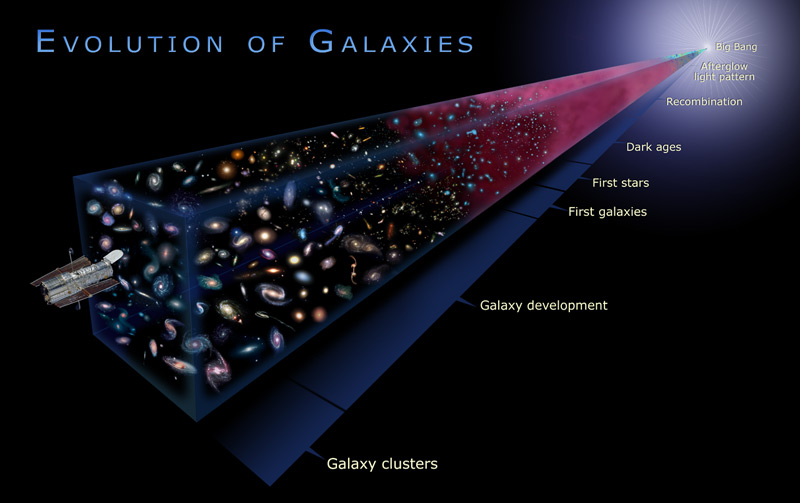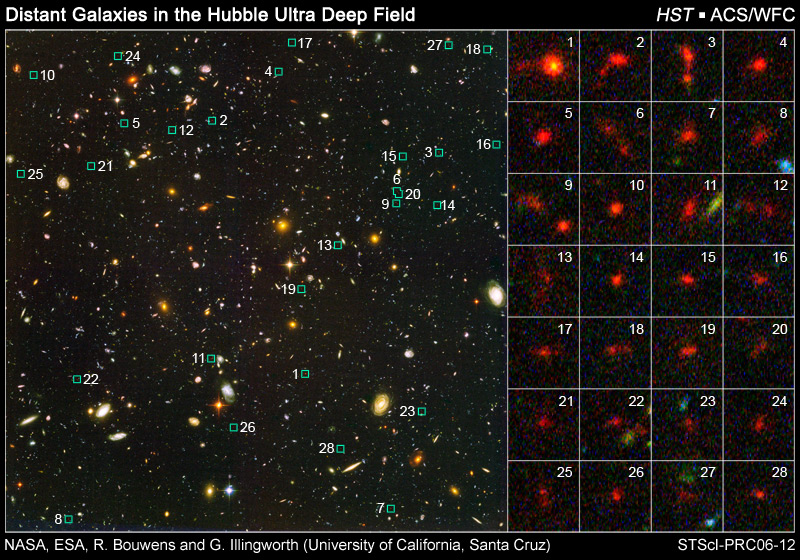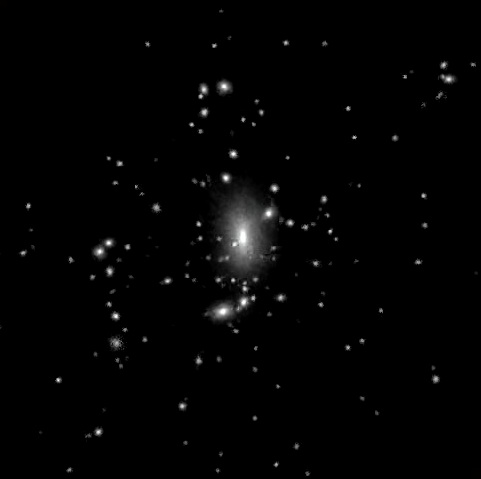

Astronomers analyzing one of the deepest views of the cosmos; made when NASA's Hubble Space Telescope pointed a single patch in the sky for 11 total days at the end of 2003. In the Hubble Ultra Deep Field images there are more than 500 galaxies visible that existed less than a billion years after the Big Bang. The galaxies captured in the Hubble Ultra Deep Field are smaller than today's giant galaxies and very bluish in color, indicating they are ablaze with star birth. The images appear red because of the galaxies' tremendous distance from Earth means that the light from their young stars took nearly 13 billion years to arrive at Earth. During the journey, the blue light was shifted to red light due to the expansion of space. Finding so many of these dwarf galaxies, but so few bright ones, is evidence for today's massive galaxies building up from mergers of smaller pieces.
This increase in galaxy size is consistent with "bottom-up" models, where galaxies grow hierarchically, through mergers and accretion of smaller satellite galaxies. This is also consistent with the idea that the sizes of galaxies match hand-in-glove to a certain fraction of the sizes of their dark-matter halos. Dark matter is an invisible form of mass that comprises most of the matter in the universe. The theory is that dark matter essentially pooled into gravitational "puddles" in the early universe that then collected normal gas that quickly contracted to build star clusters and small galaxies. These dwarf galaxies merged piece-by-piece over billions of years to build the immense spiral and elliptical galaxies we see today.

A key aspect of the hierarchical assembly of structure is that as time passes, ever larger regions halt their expansion, turn around, and collapse. This results in a steady increase over time of the size of the largest structures: after a hundred million years the first stars have formed; after a billion years the first galaxies have formed; and after a further eight or so billion years the first rich clusters of galaxies have formed. These clusters contain thousands of galaxies and seem to form at the intersection of great sheets of galaxies that constitute the galaxy web. The over-density of these intersections pulls galaxies into the apex where the cluster forms. Computer simulations allow us to visualize the growth of cluster and supercluster structures. The following digital movie simulates the formation of a rich cluster.

click to run cluster simulation video (by B. Moore, 2.7 Mb)
We live in an era of ongoing cluster assembly. All around us clusters of galaxies are being built. Within clusters, galaxies continue to interact and merge. The WMAP images of the Cosmic Microwave Background a "before" and an "after" picture. The initial density fluctuations influenced where galaxies would and would not end up in today's universe.
Just a few years ago, astronomers did not have the technology to hunt for faraway galaxies in large numbers. The installation of the Advanced Camera for Surveys aboard the Hubble Space Telescope in 2002 allowed astronomers to observe distant galaxies in the Hubble Ultra Deep Field survey. Another major step in the exploration of the universe's earliest years will occur when Hubble undergoes its next upgrade in May 2009 with the Wide Field Planetary Camera 3. When the Hubble Space Telescope's replacement, the James Webb Space Telescope, is launched (scheduled for 2013) even more galaxies at even greater distances should be discovered.
© 2009 Richard Gelderman